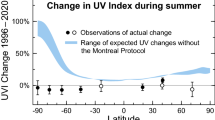Abstract
The global distribution of 1.27 μm O2 nightglow brightness observed by the TIMED/SABER satellite has been investigated to find the longitudinal structures for different seasons and latitudes. The results show that the O2 airglow is dominated by wave 4 structure at latitudes between equator and 20°S/N in both hemispheres during most seasons. At mid-latitudes around 40°S/N, the wave 1 structure is observed for most seasons with a small contribution of wave 2 during the June solstice. A comparison of the O2 and OH nightglows shows similarity in their global distributions which can be attributed to their similar photochemical mechanisms.
Similar content being viewed by others
References
Li Q, Xu J Y, Yue J, et al. Statistical characteristics of gravity wave activities observed by an OH airglow imager at Xinglong in northern China. Ann Geophys, 2011, 29: 1401–1410
Yuan W, Xu J Y, Ma R P, et al. First observation of mesospheric and thermospheric winds by a Fabry-Perot interferometer in China. Chin Sci Bull, 2010, 55: 4046–4051
Jiang G Y, Yuan W, Ning B Q, et al. A comparison of mesospheric winds measured by FPI and meteor radar located at 40N. Sci China Tech Sci, this special issue, 2012
Zhu Y J, Xu J Y, Yuan W, et al. First experiment of spectrometric observation of the Hydroxyl Emission and Rotational Temperature in the mesopause in China. Sci China Tech Sci, this special issue, 2012
Shepherd G G, Thuillier G, Solheim B H, et al. Longitudinal structure in atomic oxygen concentrations observed with WINDII on UARS. Geophys Res Lett, 1993, 20: 1303–1306
Zaragoza G, Taylor F W, López-Puertas M. Latitudinal and longitudinal behavior of the mesospheric OH nightglow layer as observed by the Improved Stratospheric and Mesospheric Sounder on UARS. J Geophys Res, 2001, 106: 80278033
Wang D Y, Ward W E, Solheim B H, et al. Longitudinal variations of green line emission rates observed by WINDII at altitudes 90–120 km during 1991–1996. J Atmos Solar-Terr Phys, 2004, 64: 1273–1286
England S L, Immel T J, Sagawa E, et al. Effect of atmospheric tides on the morphology of the quiet time, postsunset equatorial ionospheric anomaly. J Geophys Res, 2006, 111: A10S19
Xu J, Smith A K, Jiang G Y, et al. Strong longitudinal variations in the OH nightglow. Geophys Res Lett, 2010, 37: L21801
Gao H, Xu J Y, Chen G M, et al. Global distributions of OH and O2 (1.27 μm) nightglow emissions observed by TIMED satellite. Sci China Tech Sci, 2011, 54: 1–10
Shepherd G G, Roble R G, Zhang S P, et al. Tidal influence on midlatitude airglow: Comparison of satellite and ground-based observations with TIME-GCM predictions. J Geophys Res, 1998, 103: 14741–14751
Ward W E. A Simple Model of Diurnal Variations in the Mesospheric Oxygen Nightglow. Geophys Res Lett, 1999, 26: 3565–3568
Marsh D R, Smith A K, Mlynczak M G, et al. SABER observations of the OH Meinel airglow variability near the mesopause. J Geophys Res, 2006, 111: A10S05
Xu J Y, Smith A K, Liu H L, et al. Seasonal and QBO variations in the migrating diurnal tide observed by TIMED. J Geophys Res, 2009, 114: D13107
Yuan T, She C Y, Krueger D, et al. A collaborative study on temperature diurnal tide in the midlatitude mesopause region (41°N, 105°W) with Na lidar and TIMED/SABER observations. J Atmos Solar-Terr Phys, 2010, 72: 541–549
Hagan M E, Forbes J M. Migrating and nonmigrating diurnal tides in the middle and upper atmosphere excited by tropospheric latent heat release. J Geophys Res, 2002, 107: 4754–4768
Author information
Authors and Affiliations
Corresponding author
Rights and permissions
About this article
Cite this article
Gao, H., Nee, J. & Chen, G. Longitudinal distribution of O2 nightglow brightness observed by TIEMD/SABER satellite. Sci. China Technol. Sci. 55, 1258–1263 (2012). https://doi.org/10.1007/s11431-012-4802-0
Received:
Accepted:
Published:
Issue Date:
DOI: https://doi.org/10.1007/s11431-012-4802-0




